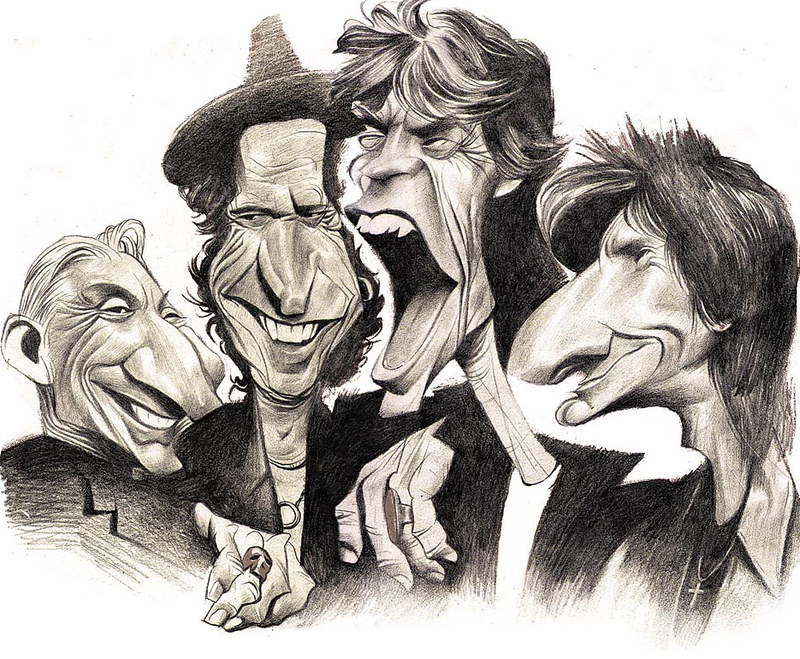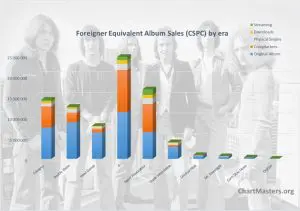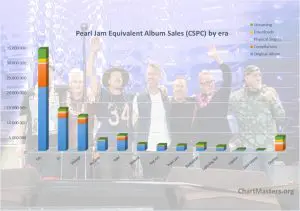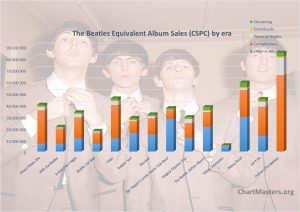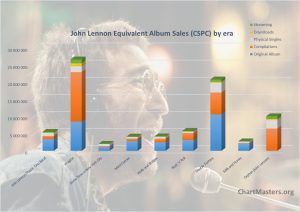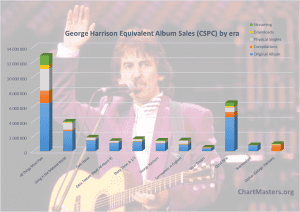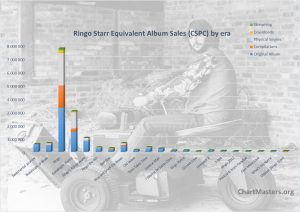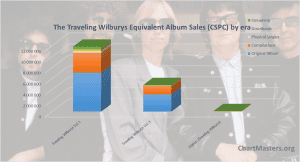The Rolling Stones albums and songs sales
How many things will change in your life within a 52 years span? An awful lot for sure. Even if you keep the same job all along, you will be retired before doing it for so long. Some things last that much though. The Eiffel Tower is still in Paris. Soccer is still the most popular sport. European unions are still alive. And the Rolling Stones are still releasing new albums.
Well, new, not completely. Blue & Lonesome is the first full album of covers from the cult band. It comes out more than a decade after their last record, A Bigger Bang in 2005.
In 1964, their first album was a massive smash with 12 weeks at #1 and 36 weeks Top 3 in the UK. Starting so strongly makes it harder to last but the success never really left Mick Jagger band. As successful as the road has been that doesn’t mean it was all pretty. Over their curse, the group knew more than 25 members, had various legal issues and even faced the death of their original founder in 1969, Brian Jones. The cult pair Mick Jagger–Keith Richards proved to be incredibly consistent though, keeping the boat up and running.
Often presented as the main competitors of the Beatles, it is clear that ultimately the Liverpool band ended up as the winner as they are the most popular music act of all-time. With no mega-selling album in their discography, some may question the legitimacy of the Rolling Stones among the elite group of biggest acts ever. We do know how much Medias love to use hyperboles, often inflating real achievements of music stars. It is now time to sort out what’s true and what isn’t over the extensive CSPC study that you are reading right now.
ChartMasters’ method: the CSPC
As usual, I’ll be using the Commensurate Sales to Popularity Concept (CSPC) in order to relevantly gauge the act’s results. It will not only bring you sales information for all albums, physical and download singles, as well as audio and video streaming. In fact, it will really determine the act’s popularity.
If you are not yet familiar with the CSPC method, below is a nice and short video of explaining the concept. I recommend watching it before reading on and to the sales figures. You’ll get the idea in just two minutes.
And if you want to know the full method as well as formulas, you can read the full introduction article.
Now let’s get into the artist’s detailed sales figures!
The Rolling Stones’ original albums sales
The Rolling Stones (1964)
- America
- US – 800,000
- Canada – N/A
- Argentina – N/A
- Brazil – N/A
- Mexico – N/A
- Asia
- Japan – N/A
- Oceania
- Australia – 75,000
- New Zealand – N/A
- Europe – 1,300,000
- UK – 840,000
- France – 80,000
- Germany – 100,000
- Italy – 30,000
- Spain – N/A
- Sweden – N/A
- Netherland – N/A
- Switzerland – N/A
- Austria – N/A
- Finland – N/A
- World – 2,500,000
12 X 5 (1964)
_coverart.jpg)
- America
- US – 900,000
- Canada – N/A
- Argentina – N/A
- Brazil – N/A
- Mexico – N/A
- Asia
- Japan – N/A
- Oceania
- Australia – 60,000
- New Zealand – N/A
- Europe – 470,000
- UK – N/A
- France – 80,000
- Germany – 125,000
- Italy – 25,000
- Spain – N/A
- Sweden – N/A
- Netherland – N/A
- Switzerland – N/A
- Austria – N/A
- Finland – N/A
- World – 1,700,000
The Rolling Stones No. 2 (1965)
:format(jpeg):mode_rgb():quality(40)/discogs-images/R-926353-1278252714.jpeg.jpg)
- America
- US – N/A
- Canada – N/A
- Argentina – N/A
- Brazil – N/A
- Mexico – N/A
- Asia
- Japan – N/A
- Oceania
- Australia – N/A
- New Zealand – N/A
- Europe – 960,000
- UK – 680,000
- France – N/A
- Germany – 100,000
- Italy – N/A
- Spain – N/A
- Sweden – N/A
- Netherland – N/A
- Switzerland – N/A
- Austria – N/A
- Finland – N/A
- World – 1,000,000
The Rolling Stones, Now! (1965)
:format(jpeg):mode_rgb():quality(40)/discogs-images/R-1383770-1313099622.jpeg.jpg)
- America
- US – 900,000
- Canada – N/A
- Argentina – N/A
- Brazil – N/A
- Mexico – N/A
- Asia
- Japan – N/A
- Oceania
- Australia – 45,000
- New Zealand – N/A
- Europe – 130,000
- UK – N/A
- France – 55,000
- Germany – N/A
- Italy – 25,000
- Spain – N/A
- Sweden – N/A
- Netherland – N/A
- Switzerland – N/A
- Austria – N/A
- Finland – N/A
- World – 1,300,000
Out of Our Heads (1965)
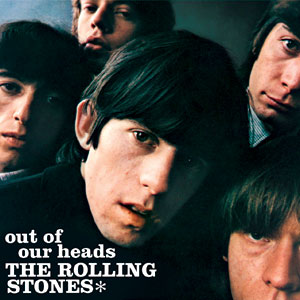
- America
- US – 1,500,000
- Canada – N/A
- Argentina – N/A
- Brazil – N/A
- Mexico – N/A
- Asia
- Japan – N/A
- Oceania
- Australia – 60,000
- New Zealand – N/A
- Europe – 850,000
- UK – 350,000
- France – 80,000
- Germany – 100,000
- Italy – 60,000
- Spain – N/A
- Sweden – N/A
- Netherland – N/A
- Switzerland – N/A
- Austria – N/A
- Finland – N/A
- World – 2,850,000
December’s Children (And Everybody’s) (1965)
:format(jpeg):mode_rgb():quality(40)/discogs-images/R-682280-1313097190.jpeg.jpg)
- America
- US – 900,000
- Canada – N/A
- Argentina – N/A
- Brazil – N/A
- Mexico – N/A
- Asia
- Japan – N/A
- Oceania
- Australia – N/A
- New Zealand – N/A
- Europe – 160,000
- UK – N/A
- France – 55,000
- Germany – N/A
- Italy -40,000
- Spain – N/A
- Sweden – N/A
- Netherland – N/A
- Switzerland – N/A
- Austria – N/A
- Finland – N/A
- World – 1,300,000
Aftermath (1966)
:format(jpeg):mode_rgb():quality(40)/discogs-images/R-4230352-1385162868-2836.jpeg.jpg)
- America
- US – 1,650,000
- Canada – N/A
- Argentina – N/A
- Brazil – N/A
- Mexico – N/A
- Asia
- Japan – N/A
- Oceania
- Australia – 70,000
- New Zealand – N/A
- Europe – 1,690,000
- UK – 600,000
- France – 135,000
- Germany – 225,000
- Italy – 150,000
- Spain – N/A
- Sweden – N/A
- Netherland – N/A
- Switzerland – N/A
- Austria – N/A
- Finland – N/A
- World – 3,900,000
Between the Buttons (1967)
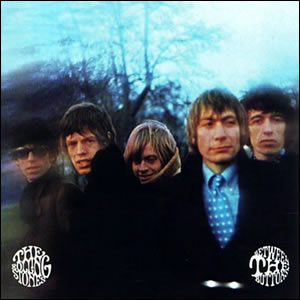
- America
- US – 1,100,000
- Canada – N/A
- Argentina – N/A
- Brazil – N/A
- Mexico – N/A
- Asia
- Japan – N/A
- Oceania
- Australia – 50,000
- New Zealand – N/A
- Europe – 750,000
- UK – 200,000
- France – 100,000
- Germany – 100,000
- Italy – 75,000
- Spain – N/A
- Sweden – N/A
- Netherland – N/A
- Switzerland – N/A
- Austria – N/A
- Finland – N/A
- World -2,200,000
Their Satanic Majesties Request (1967)
- America
- US – 1,300,000
- Canada – N/A
- Argentina – N/A
- Brazil – N/A
- Mexico – N/A
- Asia
- Japan – N/A
- Oceania
- Australia – 75,000
- New Zealand – N/A
- Europe – 710,000
- UK – 175,000
- France – 125,000
- Germany – 125,000
- Italy – 25,000
- Spain – N/A
- Sweden – N/A
- Netherland – N/A
- Switzerland – N/A
- Austria – N/A
- Finland – N/A
- World – 2,450,000
Beggars Banquet (1968)

- America
- US – 2,200,000
- Canada – 175,000
- Argentina – N/A
- Brazil – N/A
- Mexico – N/A
- Asia
- Japan – N/A
- Oceania
- Australia – 70,000
- New Zealand – N/A
- Europe – 1,100,000
- UK – 350,000
- France – 165,000
- Germany – 100,000
- Italy – 125,000
- Spain – N/A
- Sweden – N/A
- Netherland – N/A
- Switzerland – N/A
- Austria – N/A
- Finland – N/A
- World – 4,000,000
Let It Bleed (1969)
:format(jpeg):mode_rgb():quality(40)/discogs-images/R-2244952-1331736823.jpeg.jpg)
- America
- US – 3,600,000
- Canada – 300,000
- Argentina – N/A
- Brazil – N/A
- Mexico – N/A
- Asia
- Japan – 225,000
- Oceania
- Australia – 150,000
- New Zealand – N/A
- Europe – 2,210,000
- UK – 725,000
- France – 250,000
- Germany – 350,000
- Italy – 125,000
- Spain – N/A
- Sweden – N/A
- Netherland – 130,000
- Switzerland – N/A
- Austria – N/A
- Finland – N/A
- World – 7,000,000
Sticky Fingers (1971)
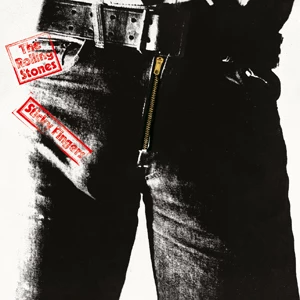
- America
- US – 4,700,000
- Canada – 400,000
- Argentina – N/A
- Brazil – N/A
- Mexico – N/A
- Asia
- Japan – 250,000
- Oceania
- Australia – 200,000
- New Zealand – N/A
- Europe – 3,160,000
- UK – 800,000
- France – 350,000
- Germany – 550,000
- Italy – 160,000
- Spain – 150,000
- Sweden – N/A
- Netherland – 300,000
- Switzerland – N/A
- Austria – N/A
- Finland – N/A
- World – 9,350,000
Exile on Main St (1972)

- America
- US – 3,850,000
- Canada – 350,000
- Argentina – N/A
- Brazil – N/A
- Mexico – N/A
- Asia
- Japan – 250,000
- Oceania
- Australia – 150,000
- New Zealand – N/A
- Europe – 2,820,000
- UK – 875,000
- France – 340,000
- Germany – 425,000
- Italy – 185,000
- Spain – 160,000
- Sweden – N/A
- Netherland – 160,000
- Switzerland – N/A
- Austria – N/A
- Finland – N/A
- World – 8,100,000
Goat Head Soup (1973)
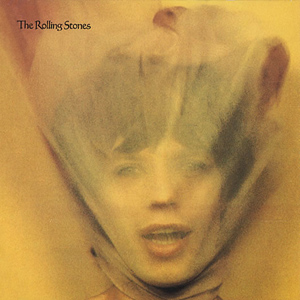
- America
- US – 3,300,000
- Canada – 275,000
- Argentina – N/A
- Brazil – N/A
- Mexico – N/A
- Asia
- Japan – 200,000
- Oceania
- Australia – 200,000
- New Zealand – N/A
- Europe – 1,910,000
- UK – 260,000
- France – 400,000
- Germany – 300,000
- Italy – 150,000
- Spain – 120,000
- Sweden – N/A
- Netherland – 140,000
- Switzerland – N/A
- Austria – N/A
- Finland – N/A
- World – 6,350,000
It’s Only Rock ‘n Roll (1974)
:format(jpeg):mode_rgb():quality(40)/discogs-images/R-1924879-1367099320-2976.jpeg.jpg)
- America
- US – 1,900,000
- Canada – 200,000
- Argentina – N/A
- Brazil – N/A
- Mexico – N/A
- Asia
- Japan – 100,000
- Oceania
- Australia – 80,000
- New Zealand – N/A
- Europe – 1,150,000
- UK – 175,000
- France – 240,000
- Germany – 150,000
- Italy – 125,000
- Spain – 100,000
- Sweden – N/A
- Netherland – 55,000
- Switzerland – N/A
- Austria – N/A
- Finland – N/A
- World – 3,700,000
Black and Blue (1976)
:format(jpeg):mode_rgb():quality(40)/discogs-images/R-6833732-1427589058-9230.jpeg.jpg)
- America
- US – 1,800,000
- Canada – 175,000
- Argentina – N/A
- Brazil – N/A
- Mexico – N/A
- Asia
- Japan – 100,000
- Oceania
- Australia – 100,000
- New Zealand – 20,000
- Europe – 1,640,000
- UK – 225,000
- France – 340,000
- Germany – 200,000
- Italy – 125,000
- Spain – 150,000
- Sweden – 50,000
- Netherland – 155,000
- Switzerland – N/A
- Austria – N/A
- Finland – N/A
- World – 4,100,000
Some Girls (1978)
- America
- US – 6,800,000
- Canada – 800,000
- Argentina – N/A
- Brazil – N/A
- Mexico – N/A
- Asia
- Japan – 250,000
- Oceania
- Australia – 150,000
- New Zealand – 40,000
- Europe – 2,520,000
- UK – 425,000
- France – 450,000
- Germany – 450,000
- Italy – 235,000
- Spain – 110,000
- Sweden – 90,000
- Netherland – 140,000
- Switzerland – N/A
- Austria – 35,000
- Finland – N/A
- World – 11,300,000
Emotional Rescue (1980)
:format(jpeg):mode_rgb():quality(40)/discogs-images/R-3731204-1342107675-6333.jpeg.jpg)
- America
- US – 2,800,000
- Canada – 350,000
- Argentina – N/A
- Brazil – N/A
- Mexico – N/A
- Asia
- Japan – 125,000
- Oceania
- Australia – 125,000
- New Zealand – 30,000
- Europe – 1,950,000
- UK – 300,000
- France – 300,000
- Germany – 320,000
- Italy – 205,000
- Spain – 90,000
- Sweden – 100,000
- Netherland – 130,000
- Switzerland – N/A
- Austria – 45,000
- Finland – N/A
- World – 5,700,000
Tattoo You (1981)
:format(jpeg):mode_rgb():quality(40)/discogs-images/R-3060168-1313843286.jpeg.jpg)
- America
- US – 4,600,000
- Canada – 575,000
- Argentina – N/A
- Brazil – N/A
- Mexico – N/A
- Asia
- Japan – 200,000
- Oceania
- Australia – 350,000
- New Zealand – 75,000
- Europe – 2,150,000
- UK – 400,000
- France – 425,000
- Germany – 250,000
- Italy – 210,000
- Spain – 150,000
- Sweden – 90,000
- Netherland – 115,000
- Switzerland – N/A
- Austria – 35,000
- Finland – N/A
- World – 8,500,000
Undercover (1983)
- America
- US – 1,300,000
- Canada – 175,000
- Argentina – N/A
- Brazil – N/A
- Mexico – N/A
- Asia
- Japan – 130,000
- Oceania
- Australia – 100,000
- New Zealand – 20,000
- Europe – 1,400,000
- UK – 200,000
- France – 175,000
- Germany – 275,000
- Italy – 110,000
- Spain – 80,000
- Sweden – 90,000
- Netherland – 100,000
- Switzerland – 40,000
- Austria – 30,000
- Finland – N/A
- World – 3,400,000
Dirty Work (1986)
:format(jpeg):mode_rgb():quality(40)/discogs-images/R-498529-1173305684.jpeg.jpg)
- America
- US – 1,400,000
- Canada – 200,000
- Argentina – N/A
- Brazil – 125,000
- Mexico – N/A
- Asia
- Japan – 160,000
- Oceania
- Australia – 100,000
- New Zealand – 20,000
- Europe – 1,600,000
- UK – 140,000
- France – 175,000
- Germany – 350,000
- Italy – 225,000
- Spain – 150,000
- Sweden – 50,000
- Netherland – 70,000
- Switzerland – 60,000
- Austria – 30,000
- Finland – N/A
- World – 3,850,000

Steel Wheels (1989)
- America
- US – 2,500,000
- Canada – 375,000
- Argentina – N/A
- Brazil – N/A
- Mexico – N/A
- Asia
- Japan – 325,000
- Oceania
- Australia – 60,000
- New Zealand – 15,000
- Europe – 1,750,000
- UK – 150,000
- France – 275,000
- Germany – 350,000
- Italy – 220,000
- Spain – 100,000
- Sweden – 70,000
- Netherland – 100,000
- Switzerland – 50,000
- Austria – 30,000
- Finland – 30,000
- World – 5,600,000
Voodoo Lounge (1994)
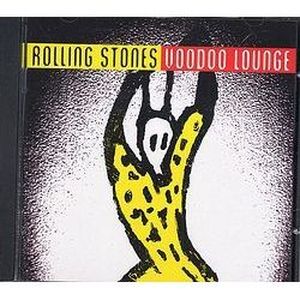
- America
- US – 2,400,000
- Canada – 350,000
- Argentina – 220,000
- Brazil – 150,000
- Mexico – 75,000
- Asia
- Japan – 300,000
- Oceania
- Australia – 90,000
- New Zealand – 15,000
- Europe – 2,460,000
- UK – 320,000
- France – 300,000
- Germany – 750,000
- Italy – 180,000
- Spain – 75,000
- Sweden – 80,000
- Netherland – 125,000
- Switzerland – 50,000
- Austria – 60,000
- Finland – N/A
- World – 6,400,000
Bridges to Babylon (1997)
:format(jpeg):mode_rgb():quality(40)/discogs-images/R-944418-1343450382-1028.jpeg.jpg)
- America
- US – 1,400,000
- Canada – 180,000
- Argentina – 130,000
- Brazil – 150,000
- Mexico – N/A
- Asia
- Japan – 250,000
- Oceania
- Australia – 30,000
- New Zealand – 5,000
- Europe – 2,190,000
- UK – 125,000
- France – 215,000
- Germany – 800,000
- Italy – 100,000
- Spain – 125,000
- Sweden – 70,000
- Netherland – 130,000
- Switzerland – 60,000
- Austria – 65,000
- Finland – 15,000
- World – 4,700,000
A Bigger Bang (2005)
.jpg)
- America
- US – 650,000
- Canada – 100,000
- Argentina – 130,000
- Brazil – 45,000
- Mexico – N/A
- Asia
- Japan – 140,000
- Oceania
- Australia – 30,000
- New Zealand – 10,000
- Europe – 1,230,000
- UK – 140,000
- France – 175,000
- Germany – 250,000
- Italy – 175,000
- Spain – 50,000
- Sweden – 55,000
- Netherland – 70,000
- Switzerland – 30,000
- Austria – 25,000
- Finland – 5,000
- World – 2,550,000
Original Album Sales – Comments
Some Girls is the band top selling studio album at 11,3 million copies sold. Nevertheless, the is barely one tenth of the massive 113,8 million units sold cumulatively by their studio albums.
At their beginning, just like the Beatles, the band issued similar but differently titled and packaged albums. I merged their debut US record The Rolling Stones (England’s Newest Hit Makers) with their UK debut The Rolling Stones due to their very similar track list and identical role in the band discography. Several following albums got UK-axed or US-axed releases, which explain their lower sales as they weren’t available globally. In fact, the only four albums under 2 million units are very exactly the four albums that weren’t issued worldwide.
This concludes on an amazing fact. In spite of topping 10 million only one time during their career, the band sold well past 2 million units of each and every album they issued everywhere. This may not seem like that much but during the 60s the market was awfully low, each million copies sold was a miracle. As an example, 1965 effort Out Of Our Heads appears with a modest 2,85 million copies sold. In reality it was everything except modest. In the US, the album was a huge #2 set blocked only by the Beatles. In the UK, it was an impressive 8 weeks #1 album. It managed exactly the same performance in Germany and was huge everywhere.
If the market was so low at that point it was because the population was lower, that not everyone had record players but also because the main format of that era was the single. Let review within’ the next pages how the band performed on that category.
1964 The Rolling Stones – 2,500,000
1964 12 X 5 – 1,700,000
1965 The Rolling Stones No. 2 – 1,000,000
1965 The Rolling Stones, Now! – 1,300,000
1965 Out of Our Heads – 2,850,000
1965 December’s Children (And Everybody’s) – 1,300,000
1966 Aftermath – 3,900,000
1967 Between the Buttons – 2,200,000
1967 Their Satanic Majesties Request – 2,450,000
1968 Beggars Banquet – 4,000,000
1969 Let It Bleed – 7,000,000
1971 Sticky Fingers – 9,350,000
1972 Exile on Main St – 8,100,000
1973 Goats Head Soup – 6,350,000
1974 It’s Only Rock ‘n Roll – 3,700,000
1976 Black and Blue – 4,100,000
1978 Some Girls – 11,300,000
1980 Emotional Rescue – 5,700,000
1981 Tattoo You – 8,500,000
1983 Undercover – 3,400,000
1986 Dirty Work – 3,850,000
1989 Steel Wheels – 5,600,000
1994 Voodoo Lounge – 6,400,000
1997 Bridges to Babylon – 4,700,000
2005 A Bigger Bang – 2,550,000
The Rolling Stones’ physical singles sales
As a reminder, the weighting is done with a 10 to 3 ratio between one album and one physical single.
Physical Singles Sales Part 1 – 64-65 Storm
From late 1964, the Rolling Stones dropped 5 consecutive #1 singles in the UK. Soon, they were also topping charts in most countries, including in the US. The main example of that situation is the ground breaking global hit (I Can’t Get Know) Satisfaction which remains their best seller to date in physical single format at 5,2 million.
In total, those singles sold a combined 18,4 million copies within’ a couple of years. This isn’t even counting with singles from that era that come as singles of compilations which will be reviewed at the end of this category.
The Rolling Stones (1964) – 591,000 equivalent albums
Not Fade Away – 950,000
Route 66 – 20,000
Tell Me – 1,000,000
12 X 5 (1964) – 742,500 equivalent albums
It’s All Over Now – 1,400,000
Time is on My Side – 1,000,000
Under the Boardwalk – 75,000
The Rolling Stones No. 2 (1965) – 0 equivalent albums
No single released
The Rolling Stones, Now! (1965) – 450,000 equivalent albums
Little Red Roaster – 1,000,000
Heart of Stone – 500,000
Out of Our Heads (1965) – 2,385,000 equivalent albums
The Last Time – 2,750,000
(I Can’t Get No) Satisfaction – 5,200,000
December’s Children (1965) – 1,350,000 equivalent albums
As Tears Go By – 1,250,000
Get Off of My Cloud – 3,250,000
Physical Singles Sales Part 2 – 60s Mature Act
If you check studio album sales, you will notice an upward trend of their albums at the end of the 60s with Let It Bleed selling 7 million units, more than three times as much as Between The Buttons. In terms of single sales, it is the exact opposite with each album era generating less and less movement. This is the typical case of an act that saw its image mature within’ the general public, after a few years of convincing hits, their albums started to be rated higher and higher.
Combined, those singles sold 7,8 million units with 40% of them coming from Paint It Black.
Aftermath (1966) – 1,305,000 equivalent albums
Paint It Black – 3,250,000
Mother’s Little Helper – 1,100,000
Between the Buttons (1967) – 420,000 equivalent albums
Let’s Spend the Night Together – 1,400,000
Their Satanic Majesties Request (1967) – 303,000 equivalent albums
She’s a Rainbow – 950,000
2000 Light Years from Home – 60,000
Beggars Banquet (1968) – 240,000 equivalent albums
Street Fighting Man – 650,000
Sympathy for the Devil – 150,000
Let It Bleed (1969) – 90,000 equivalent albums
You Can’t Always Get What You Want – 250,000
Remaining Singles – 50,000
Physical Singles Sales Part 3 – The 70s
With the album format taking more space as years passed in the 70s, the average single sales was often lower than in the previous decade. Time to time, the British cult band still registered impressive hit singles like Brown Sugar, Angie and Miss You which sold almost 10 million units combined, all three of which went #1 in the US.
All in all, their 70s singles reached nearly 17 million copies sold, continuing to build an impressive total in that format.
Sticky Fingers (1971) – 1,140,000 equivalent albums
Brown Sugar – 2,700,000
Let It Rock – 150,000
Wild Horses – 950,000
Exile on Main St (1972) – 510,000 equivalent albums
Tumbling Dice – 1,250,000
Happy – 400,000
Remaining Singles – 50,000
Goat Head Soup (1973) – 1,335,000 equivalent albums
Angie – 3,750,000
Doo Doo Doo Doo Doo (Heartbreaker) – 600,000
Star Star – 100,000
It’s Only Rock ‘n’ Roll (1974) – 390,000 equivalent albums
It’s Only Rock ‘n Roll (But I Like It) – 800,000
Ain’t Too Proud to Beg – 500,000
Black and Blue (1976) – 300,000 equivalent albums
Fool to Cry – 1,000,000
Some Girls (1978) – 1,410,000 equivalent albums
Miss You – 3,400,000
Beast of Burden – 700,000
Respectable – 300,000
Shattered – 300,000
Physical Singles Sales Part 4 – The 80s
Up to Dirty Work, all 80s albums of the band contained at least one million selling single. Considering by that record they were around for already more than 20 years, this feat is pretty unreal. Later days got harder though as since Harlem Shuffle they never got million sellers anymore.
At 11,1 million, their total single sales for their 80s singles is incredible so deep into their career.
Emotional Rescue (1980) – 915,000 equivalent albums
Emotional Rescue – 2,400,000
She’s So Cold – 650,000
Tattoo You (1981) – 1,185,000 equivalent albums
Start Me Up – 2,600,000
Waiting on a Friend – 900,000
Hang Fire – 450,000
Undercover (1983) – 420,000 equivalent albums
She Was Hot – 300,000
Undercover of the Night – 1,100,000
Dirty Work (1986) – 435,000 equivalent albums
Harlem Shuffle – 1,100,000
One Hit (To the Body) – 350,000
Steel Wheels (1989) – 382,500 equivalent albums
Mixed Emotions – 750,000
Rock and a Hard Place – 300,000
Almost Hear You Sigh – 225,000
Physical Singles Sales Part 5 – Closing & Re-opening
This next batch adds both later singles of the band as well as all hits that came out of best of albums, all packaged into the Orphan Album folder. This section includes various huge smashes led by the classic Honky Tonk Women.
This batch of singles sold an additional 18,4 million copies, bringing their cumulative tally to 72,8 million physical singles sold, one of the highest total an act ever achieved.
Voodoo Lounge (1994) – 247,500 equivalent albums
Love Is Strong – 300,000
You Got Me Rocking – 150,000
Out of Tears – 275,000
I Go Wild – 100,000
Bridges to Babylon (1997) – 142,500 equivalent albums
Anybody Seen My Baby? – 200,000
Saint of Me – 200,000
Out of Control – 75,000
A Bigger Bang (2005) – 60,000 equivalent albums
Streets of Love – 150,000
Remaining Singles – 50,000
Orphan album – 5,080,500 equivalent albums
19th Nervous Breakdown – 2,750,000
Have You Seen Your Mother, Baby, Standing in the Shadow? – 1,250,000
Come On – 250,000
Highwire – 325,000
Don’t Stop – 75,000
Little Queenie – 150,000
Fortune Teller – 50,000
I Don’t Know Why – 250,000
Out of Time – 200,000
I Wanna Be Your Man – 600,000
Sad Day – 60,000
Going to a Go-Go – 650,000
Like a Rolling Stone – 275,000
Dandelion – 550,000
Honky Tonk Women – 3,900,000
Jumpin’ Jack Flash – 2,800,000
We Love You – 2,400,000
Remaining Singles – 400,000
The Rolling Stones’ digital singles sales
As a reminder, the weighting is done with a 10 to 1 ratio between one album and one digital single.
Digital Singles Sales Part 1 – 60s
In this first listing of songs in digital format we notice huge gaps between initial success in physical format and enduring appeal highlighted by digital sales. Examples from include Get Off of My Cloud or The Last Time which were huge first but not that big nowadays and in the other side Sympathy For The Devil or Gimme Shelter, songs not even properly released as singles but that feature among their very favorites in our day and age.
This first block of songs sold a combined 24,9 million units in digital format.
The Rolling Stones (1964) – 120,000 equivalent albums
Not Fade Away – 200,000
Route 66 – 200,000
Remaining tracks – 400,000
12 X 5 (1964) – 135,000 equivalent albums
It’s All Over Now – 200,000
Time is on My Side – 400,000
Remaining tracks – 300,000
The Rolling Stones No. 2 (1965) – 90,000 equivalent albums
Remaining tracks – 600,000
The Rolling Stones, Now! (1965) – 75,000 equivalent albums
Little Red Roaster – 300,000
Heart of Stone – 100,000
Remaining tracks – 100,000
Out of Our Heads (1965) – 540,000 equivalent albums
The Last Time – 300,000
Play with Fire – 300,000
(I Can’t Get No) Satisfaction – 2,700,000
Remaining tracks – 300,000
December’s Children (1965) – 135,000 equivalent albums
As Tears Go By – 300,000
Get Off of My Cloud – 300,000
Remaining tracks – 300,000
Aftermath (1966) – 855,000 equivalent albums
Paint It Black – 4,300,000
Under My Thumb – 900,000
Mother’s Little Helper – 200,000
Lady Jane – 100,000
Remaining tracks – 200,000
Between the Buttons (1967) – 135,000 equivalent albums
Let’s Spend the Night Together – 300,000
Ruby Tuesday – 400,000
Remaining tracks – 200,000
Their Satanic Majesties Request (1967) – 90,000 equivalent albums
She’s a Rainbow – 400,000
Remaining tracks – 200,000
Beggars Banquet (1968) – 630,000 equivalent albums
Street Fighting Man – 400,000
Sympathy for the Devil – 3,200,000
Remaining tracks – 600,000
Let It Bleed (1969) – 930,000 equivalent albums
Gimme Shelter – 3,300,000
You Can’t Always Get What You Want – 1,200,000
Honky Tonk Women – 1,000,000
Remaining tracks – 700,000
Digital Singles Sales Part 2 – 70s
With their 70s catalog, the pattern seen previously is repeated with several dark horses performed impressively well. This includes songs like Wild Horses or Beast of Burden that easily eclipse the likes Miss You or Tumbling Dice.
This set adds for 12,6 million digital sales.
Sticky Fingers (1971) – 690,000 equivalent albums
Brown Sugar – 1,600,000
Wild Horses – 1,500,000
Can’t You Hear Me Knocking – 500,000
Remaining tracks – 1,000,000
Exile on Main St (1972) – 345,000 equivalent albums
Tumbling Dice – 500,000
Sweet Black Angel – 200,000
Rocks Off – 200,000
Happy – 200,000
Remaining tracks – 1,200,000
Goat Head Soup (1973) – 285,000 equivalent albums
Angie – 1,600,000
Remaining tracks – 300,000
It’s Only Rock ‘n’ Roll (1974) – 60,000 equivalent albums
It’s Only Rock ‘n Roll (But I Like It) – 200,000
Remaining tracks – 200,000
Black and Blue (1976) – 60,000 equivalent albums
Fool to Cry – 200,000
Remaining tracks – 200,000
Some Girls (1978) – 450,000 equivalent albums
Miss You – 500,000
Beast of Burden – 1,900,000
Remaining tracks – 600,000
Digital Singles Sales Part 3 – 80s onwards and orphan songs
Apart from the strong Start Me Up, there is not much to notice on those remaining hits. They increase the overall digital single sales total to a notable 46,2 million units.
Emotional Rescue (1980) – 45,000 equivalent albums
Emotional Rescue – 100,000
She’s So Cold – 100,000
Remaining tracks – 100,000
Tattoo You (1981) – 480,000 equivalent albums
Start Me Up – 2,400,000
Remaining tracks – 800,000
Undercover (1983) – 30,000 equivalent albums
She Was Hot – 100,000
Remaining tracks – 100,000
Dirty Work (1986) – 30,000 equivalent albums
Harlem Shuffle – 100,000
Remaining tracks – 100,000
Steel Wheels (1989) – 45,000 equivalent albums
Mixed Emotions – 100,000
Rock and a Hard Place – 100,000
Remaining tracks – 100,000
Voodoo Lounge (1994) – 30,000 equivalent albums
Love Is Strong – 100,000
Remaining tracks – 100,000
Bridges to Babylon (1997) – 60,000 equivalent albums
Anybody Seen My Baby? – 200,000
Remaining tracks – 200,000
A Bigger Bang (2005) – 150,000 equivalent albums
Streets of Love – 300,000
Remaining tracks -700,000
Orphan album – 435,000 equivalent albums
Jumpin’ Jack Flash – 900,000
Remaining tracks – 2,000,000
The Rolling Stones’ streaming sales
The table below lists Spotify streaming of all songs from the five albums we are studying. The Comprehensive Streaming is reached by multiplying Spotify figures by 68/26. In fact, as shown in IFPI 2015 Report, there were 68 million paying subscribers to all streaming platforms by the end of 2015. While the exact count of Spotify paying subscribers by the end of 2015 is unknown, that figure reached 20 million in June 2015 and 30 million in March 2016, thus an estimated 26 million is used as of the end of 2015.
The equivalent album sales is the division of the comprehensive streaming figure by 1500 as it is now the norm in the new industry model.
Streaming Part 1 – 1964 Newest Hit Makers
With no song cracking 10 million Spotify streams as of now, the Rolling Stones 1964 albums aren’t record breakers on that area. Nevertheless, with all songs over 400,000 plays and many tracks in the million club, they are far from being bad performers considering they are more than 50 years old. The most played song from those R&B / Jazz covers years appears to be Time Is On My Side.
In terms of equivalent album sales, those results represent 29,000 and 36,000 units for The Rolling Stones and 12 x 5 respectively.
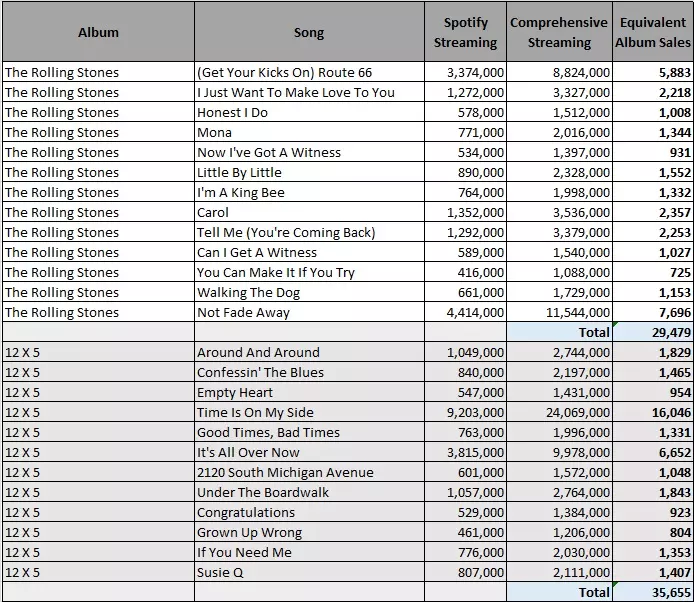
Streaming Part 2 – 1965 Satisfaction
Releasing different albums in the US and the UK led the group discography to grow extremely fast with as many as four albums coming out in 1965.
If all those albums contain at least one song over 5 million plays, the one standing out of the pack is Out Of Our Heads thanks to the massive smash hit (I Can’t Get No) Satisfaction which is up to an impressive 78 million spins. A ground breaking hit upon release way back in 1965 – notably the band first #1 singles in the US – the song is still as hot as ever more than half a century later. In the other side, Get Off Of My Cloud, which was also a worldwide #1 smash, has a respectable 7 million plays but that still pales in regards to the previous single.
In terms of equivalent album sales, while Out Of Our Heads largely benefits from Satisfaction to get 167,000 equivalent units overall. On their side, the remaining albums are all in the 20,000 to 36,000 units range just like their predecessors.
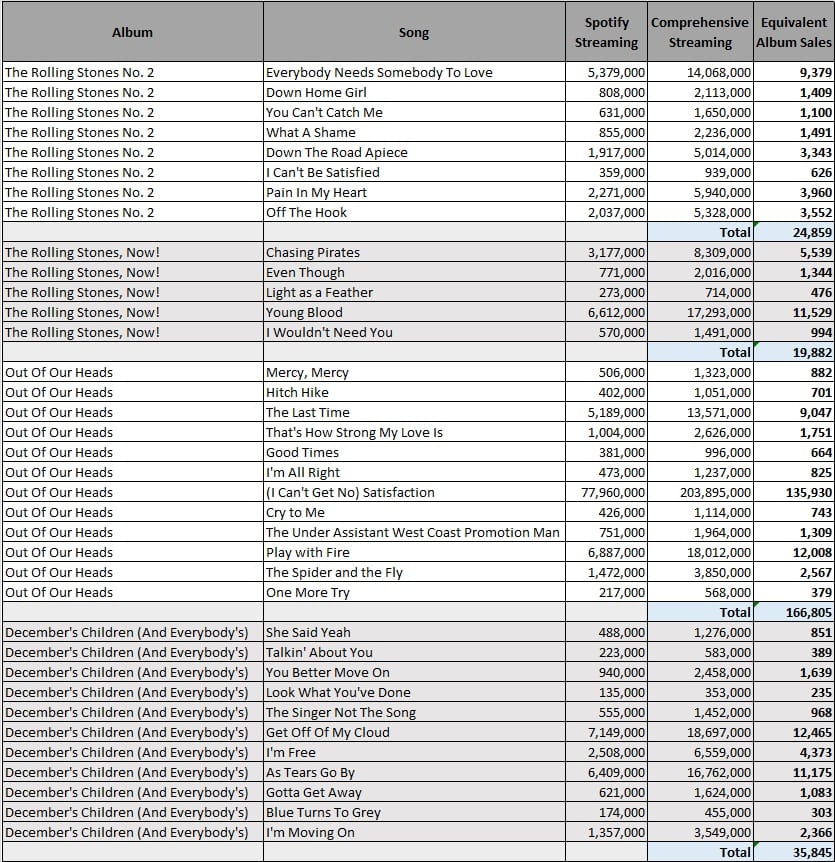
Streaming Part 3 – Painting hits
On a period that saw the band first compilations being already released, the new material of the Rolling Stones was still highly successful. Aftermath is home of the cult Paint It Black which registers a gigantic 113 million streams, arguably one of the highest totals of all songs from the 60s as it is among the only 5 songs from that decade which already broke the 100 million barrier.
Behind such a stellar hit, the 24 million plays of Under My Thumb almost look bad while in reality that’s enough to make it one of the 100 most remembered songs of the decade. Such results provide Aftermath a huge 261,000 equivalent album sales. At 43,000 units Between The Buttons has a good showing although nowhere near contemporary albums of the group.
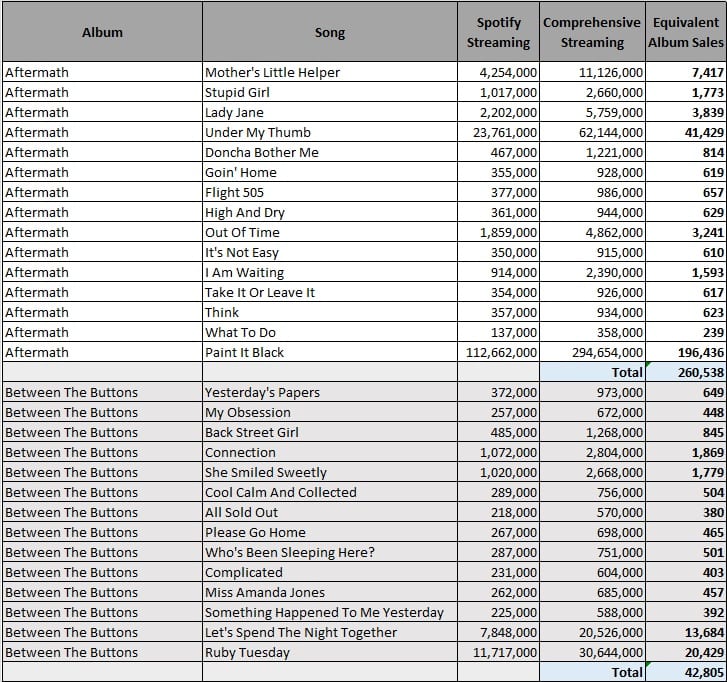
Streaming Part 4 – Gimme Hits
The impressive string of hits of the Rolling Stones keeps going on with those late 60s albums.
She’s A Rainbow already has a good 10 million streams with the parent album getting 26,000 equivalent album sales. That’s just a small portion of the success both Beggars Banquet and Let It Bleed are enjoying in the streaming era.
Both albums are strongly supported by one historical smash. Both Sympathy For the Devil and Gimme Shelter appear among the Top 10 biggest songs of the 60s, increasing the band tally to an incredible 3 songs in that superb elite group.
Overall, Let It Bleed is pretty incredible too. Apart from Gimme Shelter, it has two more songs at over 25 million, Honky Tonk Women and You Can’t Always Get What You Want. More, all songs from it are close or over 3 million. Such consistent scores provide it 294,000 equivalent album sales, which is more than many successful albums from recent years.
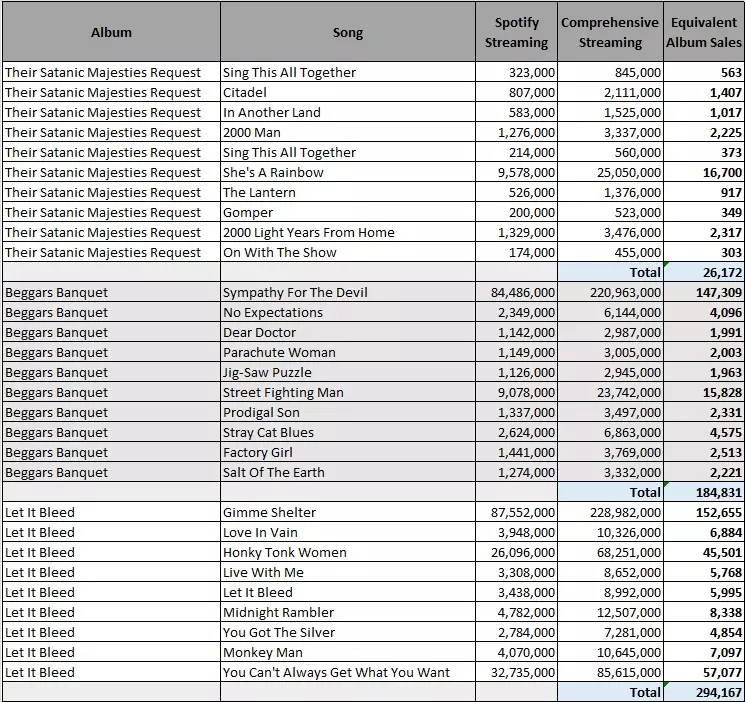
Streaming Part 5 – Wild Hits
Hits, hits and more hits. During the 60s, the Rolling Stones had as many as 8 #1 singles in the UK and 5 in the US plus countless Top 10s. Getting into the 70s, very few things changed as smashes continued to come in.
Their profile was even increasing once more. Sticky Fingers has been their first album to top charts in both the US and the UK. Then, Exile on Main St. reproduced the feat with ease.
While both albums appear to be insanely consistent, they do not match Let It Bleed total. Sticky Fingers does contain two mega-hits, Brown Sugar and Wild Horses, both over 40 million streams, unlike Exile on Main St. which is topped by Tumbling Dice at a relatively low – to the band standards – 13 million.
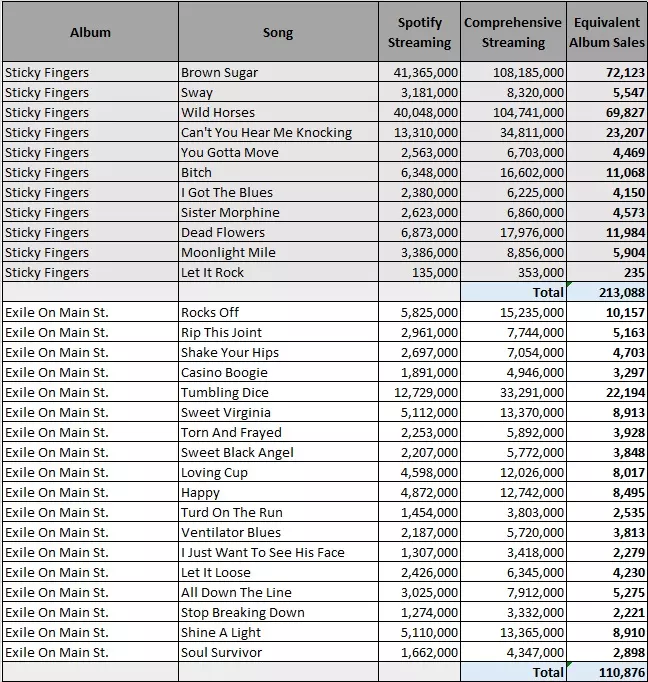
Streaming Part 6 – Angie No More
Angie, one more absolutely cult song. With so many albums containing at least one widely popular smash there is no wonder why the Rolling Stones issued so many greatest hits albums.
Apart from Angie though, those 1973-1976 years are a real step back for the band. Album tracks are far from the multi-million figures of some past albums while biggest songs of It’s Only Rock ‘N Roll and Black And Blue are stuck on 6 million and 4 million respectively. That lack of hits and consistence give those two albums the lowest album sales equivalent so far.
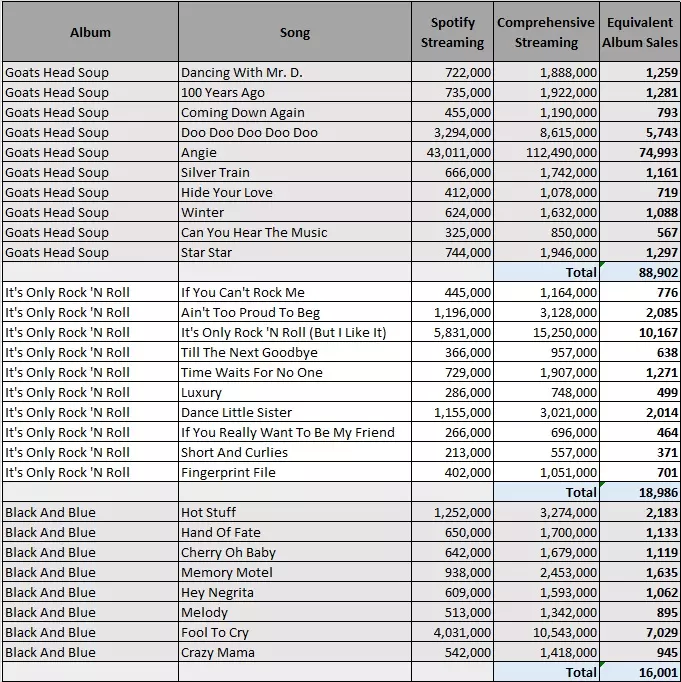
Streaming Part 7 – Gimme Hits
When an artist popularity starts decelerating many years after his debut, it is hard to turn things around and fully recover the hype. That difficult task was fully achieved by the Rolling Stones twice within a few years.
Coming back from a relatively disappointing Black And Blue, they made it big again with Some Girls album. From 2016 perspective, it looks like it’s Beast Of Burden that regenerated them. If that song has a superb 50 million plays on streaming today, at the time the huge comeback was Miss You, which reached #1 in the US some five years after the last song that peaked higher than #10 – the #1 hit Angie.
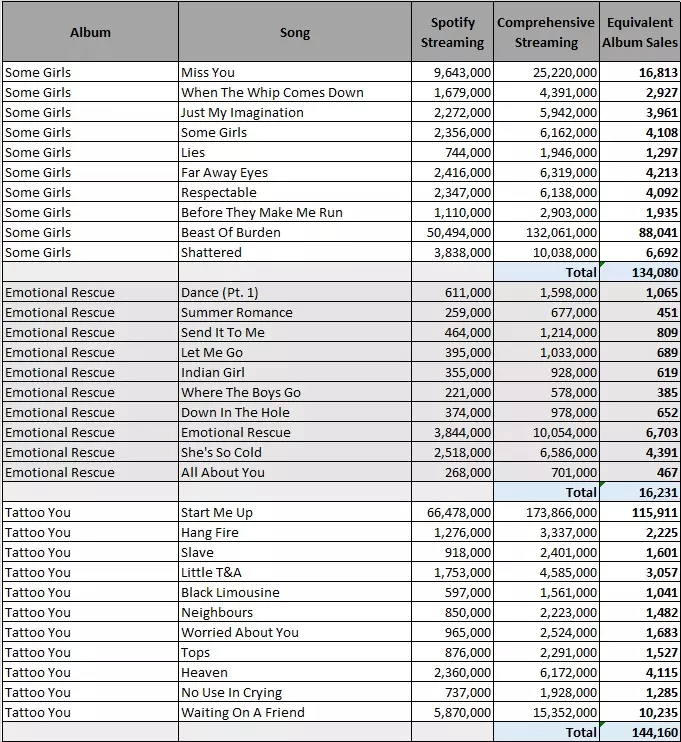
Streaming Part 8 – Dirty Years
Upon release all those three albums were OK sellers. Steel Wheels era was even a nice return to form with both album sales in the rise and a record breaking accompanying tour. Watching streaming figures though lets no doubt – there isn’t much material remembered from that period.
With no song reaching even 3 million plays and some tracks dropping below the 100,000 mark, those LPs combine for less than 30,000 equivalent album sales in streaming format.
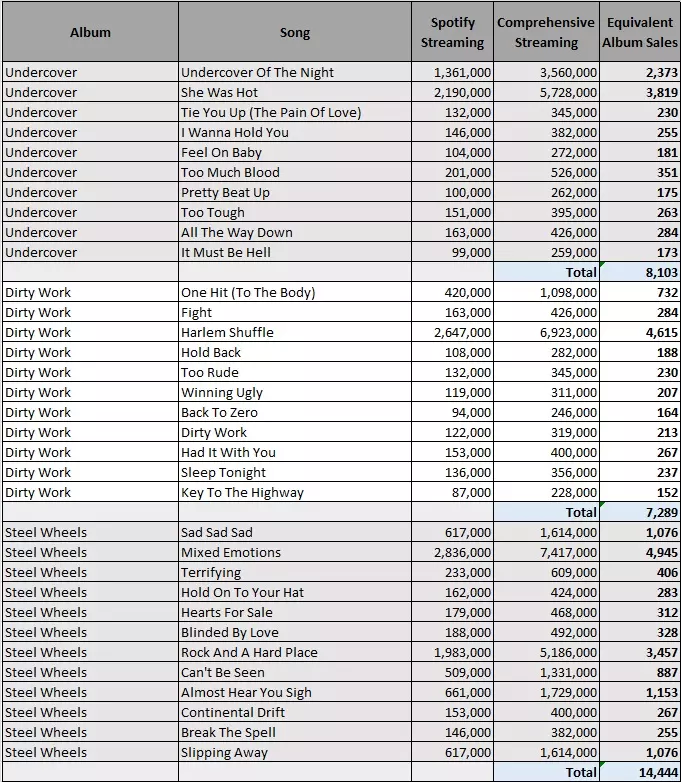
Streaming Part 9 – Still Alive in the 90s
Now more than 30 years into their career, the Rolling Stones were still able to remain relevant. Both Voodoo Lounge and Bridges To Babylon had mixed results in the band main original markets like the US and the UK but pretty good ones elsewhere like Japan or Germany.
While the former success isn’t translated into streaming figures, Bridges To Babylon appears to be enjoying a catalog appeal bigger than expected. Although they are nowhere near their 60s astronomical hits, their top 2 hits since 1983 to date belong to this album.
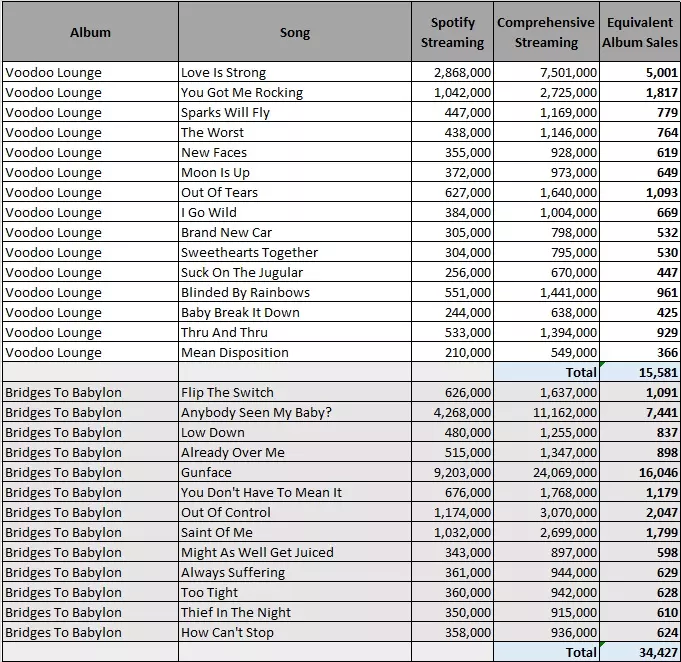
Streaming Part 10 – Unfinished Business
In spite of missing big hits, A Bigger Bang remains the band most consistent record since Tattoo You has all its 16 tracks surpass 350,000 plays, which translates into 22,000 equivalent album sales.
Obviously, upcoming album Blue & Lonesome is just getting started, thus, while it is still not released, I’ll be adding it into Orphan Album.

Streaming Part 11 – Orphan Album
Since the 70s the music industry norm is to work on an album-era basis. First, a lead single comes out, then the album, then additional singles from the album.
In the 60s though, both albums and singles were often independent as the latter’s weren’t part of the formers. The Rolling Stones also issued many compilations with exclusive singles. Some of the band biggest chart hits of that era logically appear under Orphan Album folder then, most notably Jumpin’ Jack Flash.
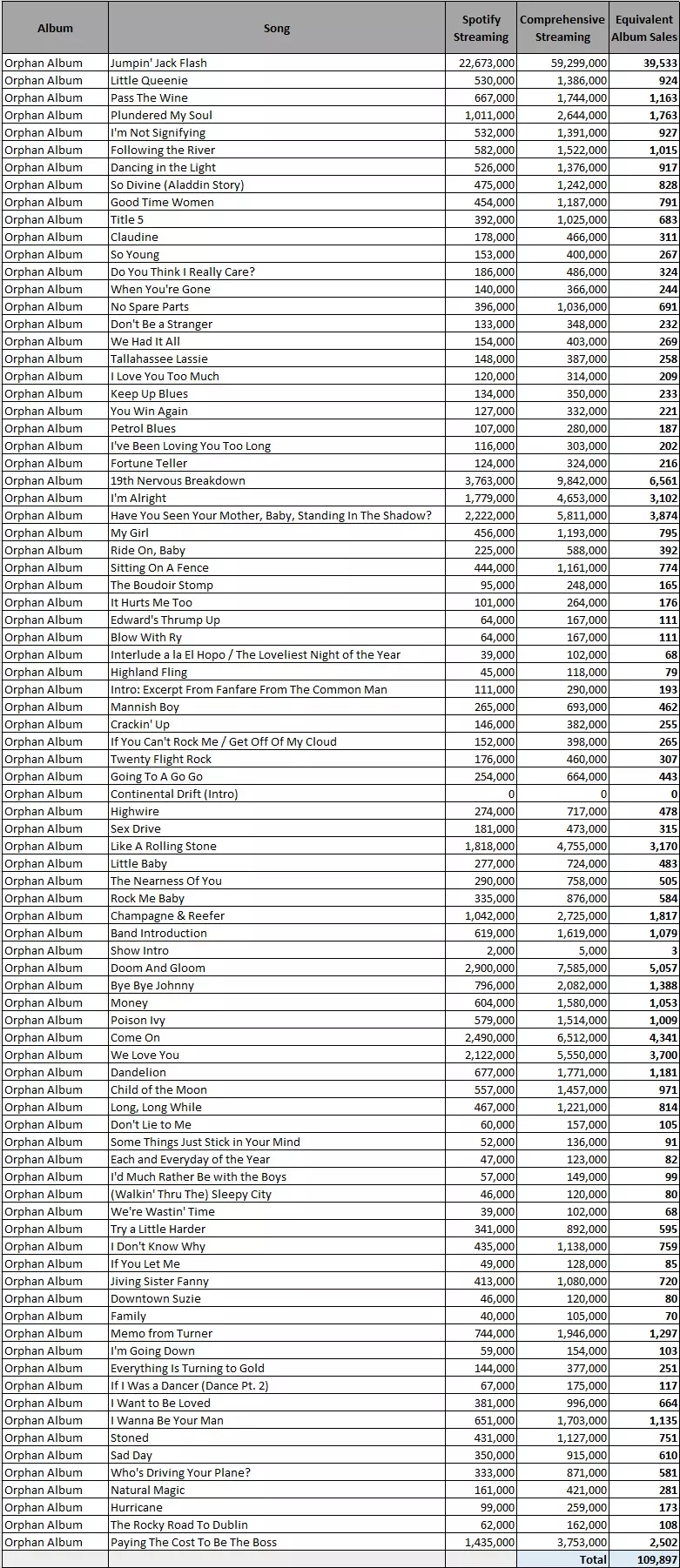
The Rolling Stones’ full length related records sales
Just as it had to be expected for a band with such an extensive discography of studio albums, the Rolling Stones released plenty a compilations, live albums, box sets or music videos. There is one pivotal event to mention first when we study their best of albums. After the release of Let It Bleed in 1969, their recording contract with Decca Records expired. In 1970, the band created their own label Rolling Stones Records, quickly issuing Sticky Fingers on it. As both record labels are fully independent from each other and not really in good terms, all best of albums of the band were covering or 1964 to 1971 years or post 1971 stuff, with only Sticky Fingers tracks being part of both packages.
Thus, Big Hits 1 and 2, Hot Rocks or Rolled Gold cover all their earlier outputs while the likes Rewind or Jump Back cover their hits from 1971 to their respective releases.
In 2002, almost four decades after their debut, the first career-spanning compilation came out, 40 Licks, containing one CD for each era. Deleted after a few years only, another similar package came out in 2012, GRRR!, itself appearing to be discontinued since a couple of years.
On top of that, the band also got various area-specific best of albums. Jump Back wasn’t released in the US first while Hot Rocks wasn’t issued in most countries outside North America. There is also many local best of albums that came out. All those different periods coverage, constant deletion/re-activation and distinct releases per area prevented them from having one truly massive selling compilation but altogether they amount for an impressive total that we are going to detail during the upcoming pages.
Part 1 – Decca Era, Major Compilations I
How to understand this table? If you check for example Hot Rocks 1964-1971 compilation album line, those figures mean it sold 12,800,000 units worldwide. The second statistics column means all versions of all songs included on this package add for 624 million streaming plays on Spotify.
The second part at the right of the table shows how many streams are coming from each original album plus the share it represents on the overall package streams. Thus, streaming figures tell us Aftermath songs are responsible for 23% of the Hot Rocks 1964-1971 tracklist attractiveness, which means it generated 2,888,000 of its 12,800,000 album sales and so on for the other records.
Comments now, those three compilations generated a huge 25 million sales combined based on the band early songs only. Both Big Hits and Hot Rocks include their most well-known songs while Though the Past focuses on secondary songs. Thanks to the presence of some of their all-time biggest tracks on them, Out Of Our Heads, Aftermath, Beggars Banquet and Let It Bleed are the main compilation sales generators among 60s albums.
In the other side, their very first albums fail to attract many buyers as their songs popularity fell short of their biggest standards. Some albums like Rolling Stones vol 2, are barely, if not at all, represented on those packages.
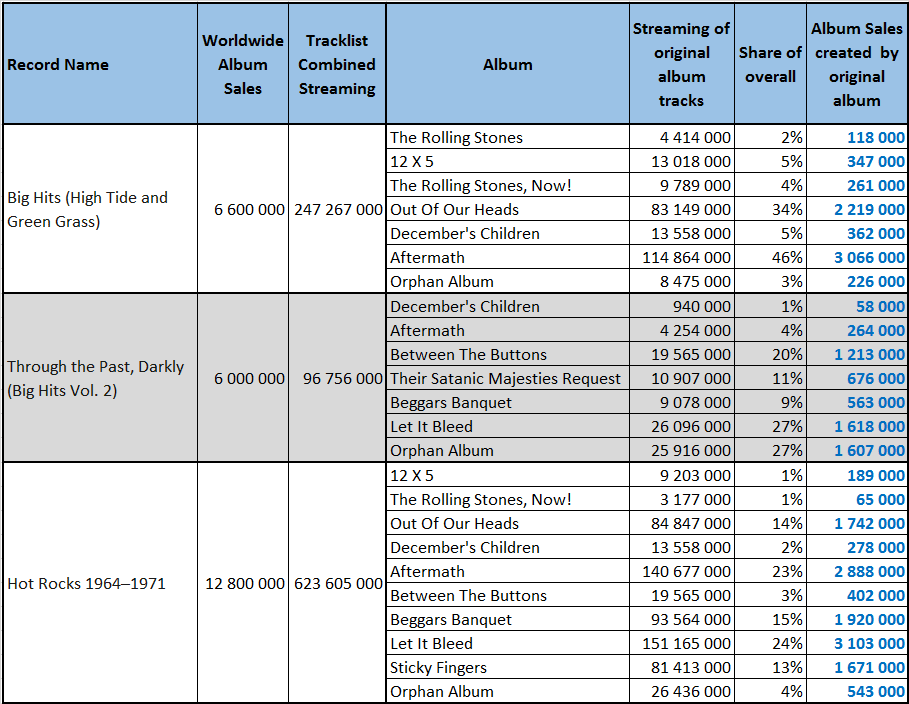
BONUS – Original Compilation Sales: Hot Rocks 1964-1971 (1971)
Hot Rocks‘ sales are especially impressive if we consider it was released in the UK and almost everywhere outside North America in 1990 only, when it was reissued as a CD. By then, the group had amassed many new hits so it was much harder to sell a compilation based on only one part of their discography. In UK, a package with the second part of the best of is included while French figure includes Les Années Stones which really was Hot Rocks but titled differently for that market.
- America
- US – 8,400,000
- Canada – 700,000
- Argentina – N/A
- Brazil – N/A
- Mexico – N/A
- Asia
- Japan – 200,000
- Oceania
- Australia – 125,000
- New Zealand – 35,000
- Europe – 2,500,000
- UK – 1,050,000
- France – 400,000
- Germany – N/A
- Italy – 200,000
- Spain – N/A
- Sweden – N/A
- Netherland – 100,000
- Switzerland – N/A
- Austria – N/A
- Finland – N/A
- World – 12,800,000
Part 2 – Decca Era, Major Compilations II
More Hot Rocks, just like Through The Past, avoids the biggest hits which were already feature in the first volume of each compilation. This creates an unusual pattern in sales distributions among studio albums.
In the other side, Singles Collection and The Very Best Of are typical Decca compilations with the same previously mentioned albums being responsible for most of their sales. Released much latter and never really promoted, those records sold well steadily but nowhere near amounts of past compilations.
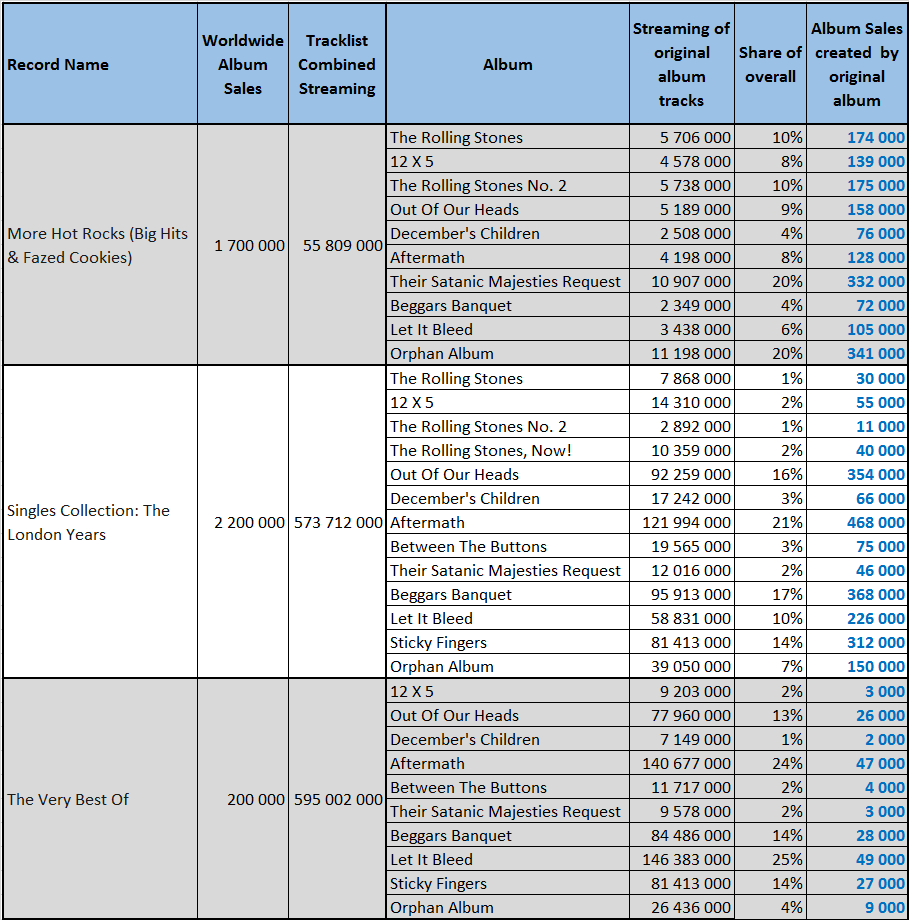
Part 3 – Decca Era, Minor Compilations I
Apart from Gimme Shelter which came out in a few countries only but features various big hits, the remaining albums mostly focus on secondary singles or specific periods which creates very diverse sales distribution once again. Giving the extensive amount of compilations featuring the same songs, all those studio albums are receiving huge sales from those packages. Of course, if you are used to read CSPC articles, you understood this explains why original studio albums aren’t mega sellers, quite simply because their attractiveness has been spread over various different records. Just a few more pages before seeing the comprehensive total of sales generated by each of the Rolling Stones albums…
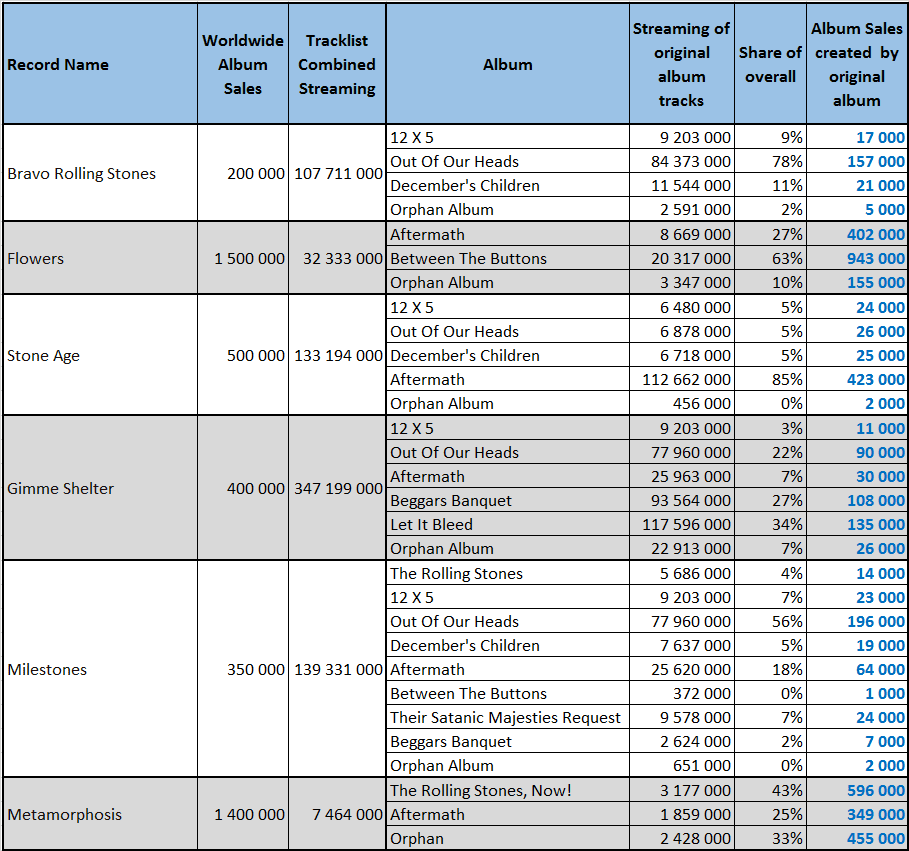
Part 4 – Decca Era, Minor Compilations II
Those three sets are standard Decca compilations with the expected track list featuring the likes Paint It Black, Satisfaction or Sympathy For The Devil. They are still moved into the minor compilations part because they were mostly released locally. Rolled Gold was a strong seller in the UK in 1975 but wasn’t released in most countries until 2007. Similarly Story of The Stones sold almost exclusively in the UK.
Greatest Hits was released under budget labels under several names in various countries. 30 Greatest Hits in Germany, Greatest Hits in Canada or Get Stoned in the UK, those albums are in reality all the same 1977 package.
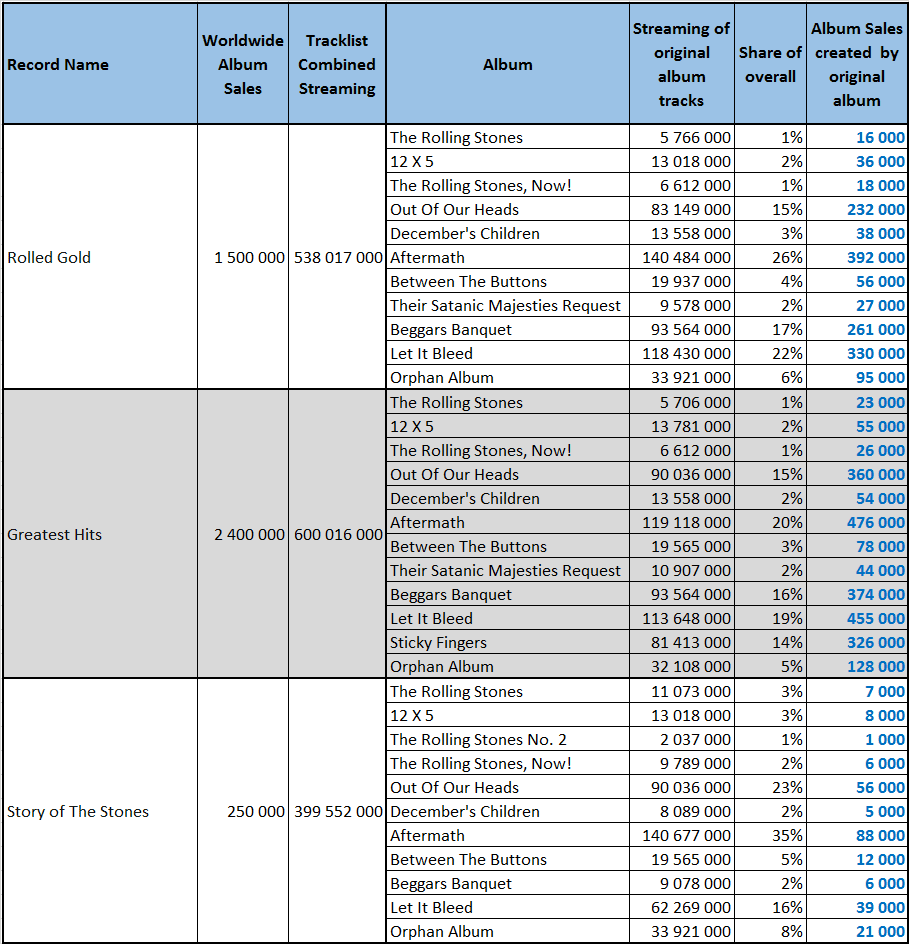
Part 5 – Rolling Stones Records Era – Compilations
Moving into the Rolling Stones Records era, we now get compilations covering years from 1971 to the respective release date of those albums.
Sucking in the Seventies and Rarities both feature moderate hits or lost gems plus one cult song, Beast Of Burden, which gives a large chunk of their sales to Some Girls.
Remaining compilations include all the hottest songs. Just like their 60s catalog, the one from 1973 owns four albums which contain sizable hits, thus eclipsing remaining albums. Sticky Fingers has the duo Wild Horses / Brown Sugar, Goats Head Soup album owns Angie, Some Girls contains Beast Of Burden and Tattoo You is driven by Start Me Up. As those five songs combined are responsible for roughly 80% of the post-1971 era strength, the related studio albums logically get rewarded sales of those compilations.
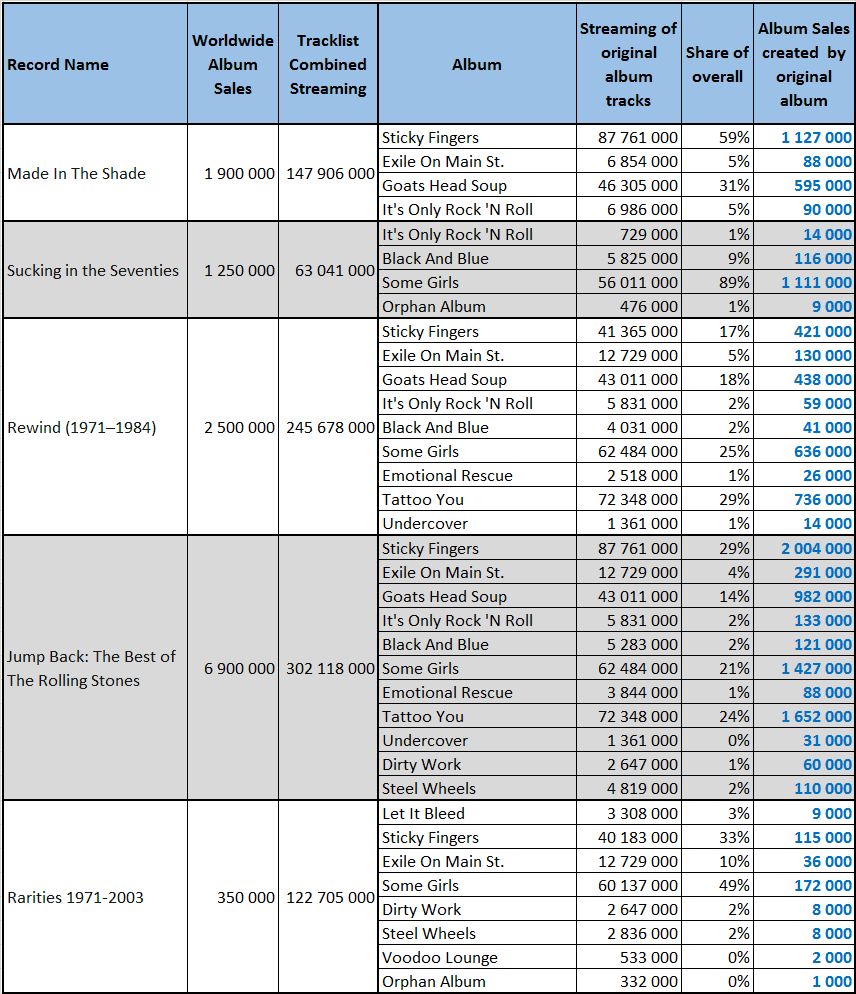
Part 6 – Career Spanning Compilations
At last we reach career spanning compilations, 2002 album 40 Licks and 2012 set GRRR!. Both albums are extensive ones with 2/3/4 CDs versions.
In terms of distributions, they are the perfect combination of the two previously checked eras. Thus, you can notice 8 albums getting relevant shares of overall sets but remaining studio albums providing very few additional interest to them.
An interesting point is that both albums got quickly deleted. The first thinking is “wow, all Rolling Stones hits into one package that’s huge”. That positive thinking is very exactly the problem though. If you check the cumulative streaming on Spotify of those albums track lists, they both top 820 million streams. To give you an idea, that’s more than Madonna complete discography. In concrete words, those sets contain way too much value. Some 20% of their appeal would be easily enough to generate solid catalog sales already so putting that many attractive songs into one album only is truly a waste of potential. As a result, both albums were used as Christmas cash-ins to provide easy cash to their labels, but both bring a negative expected value on long term in comparison to several distinct compilations spreading their catalog appeal.
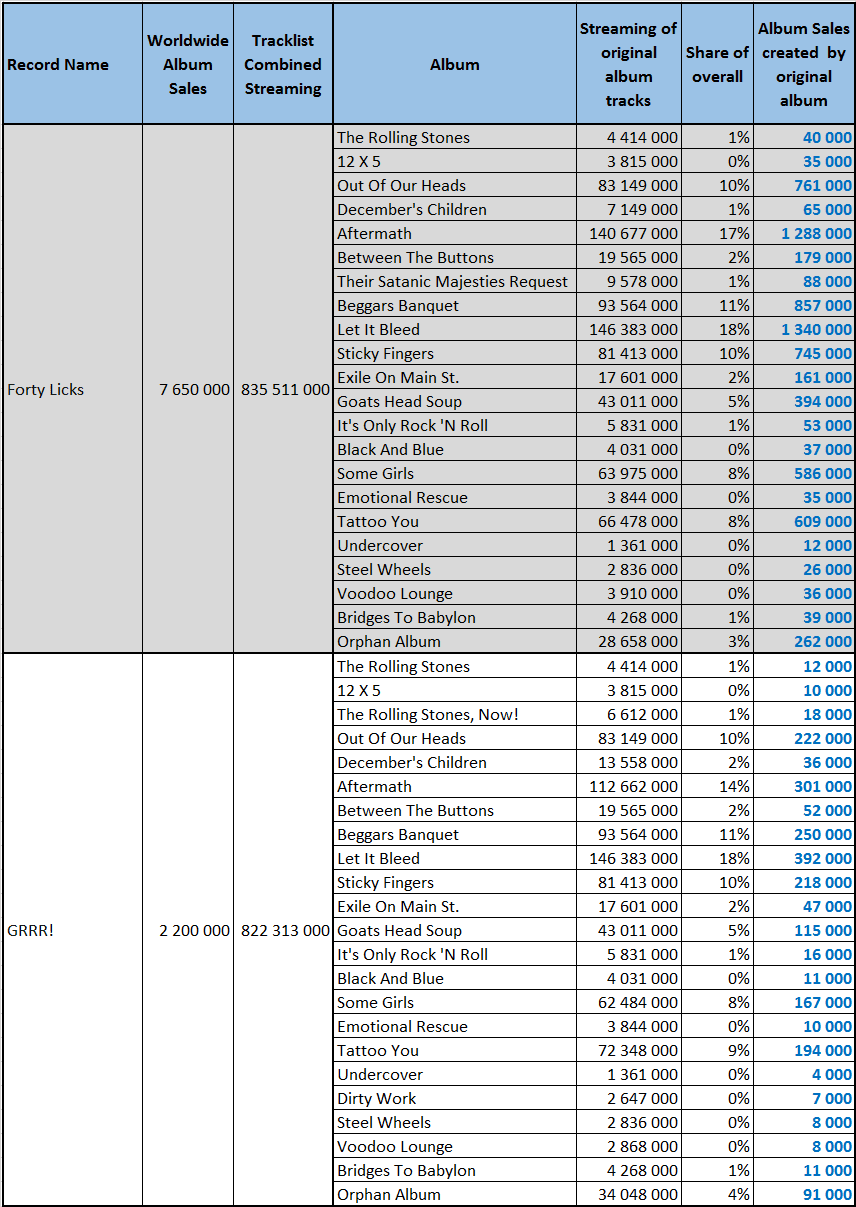
Part 7 – Live Albums I
Up to now we saw that the Rolling Stones sold a huge amount of studio albums, loads of compilations, tons of physical singles and got incredible catalog sales in both digital formats downloads and streaming. As it wasn’t enough, the rock stars also happen to be massive sellers of live albums.
Issuing one every 4 or 5 years, all of them ended up being incredibly successful. Selling routinely 3 million units of each live album is already huge, but doing so when studio albums sold barely more is even more surreal.
Obviously, the same studio albums are responsible for their sales than on their compilations. The distribution is less stable though as the band left out some of their big hits on one tour or an other.

Part 8 – Live Albums II
In the 90s, along with their record breaking world tours, the Rolling Stones also issued big accompanying live albums. Both Flashpoint and Stripped sold 4 million units.
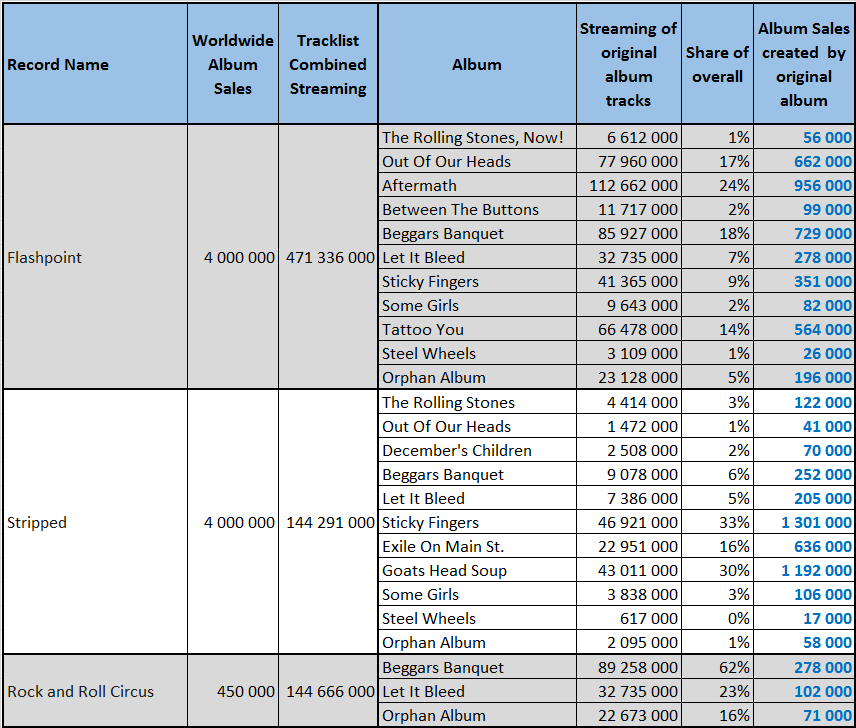
Part 9 – Live Albums III
Some more live albums from the last 20 years with the last three featuring standard track lists while No Security is heavily Let It Bleed-axed.

Part 10 – Music Videos I
Now reaching music videos category – in all formats from VHS to DVD – we will met several records close to compilations and live albums that came out along with them like Video Rewind which accompanied Rewind 1971-1984. I won’t be commenting them much as they display results which are on a par with patterns already met.
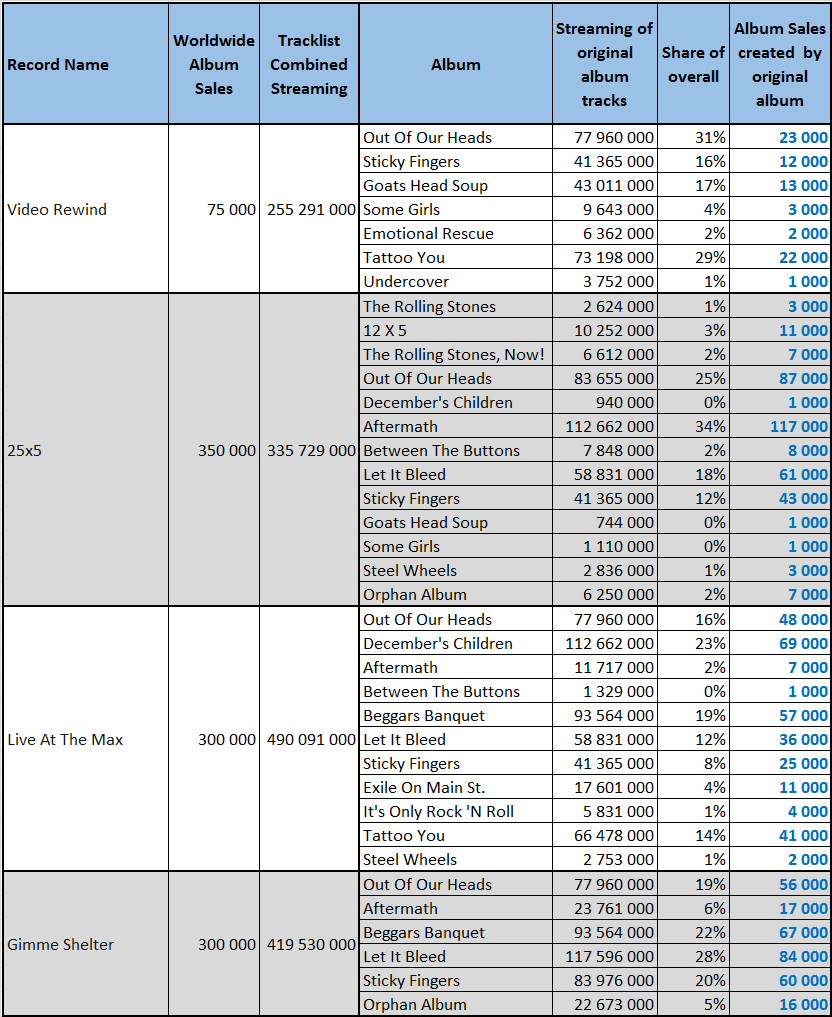
Part 11 – Music Videos II
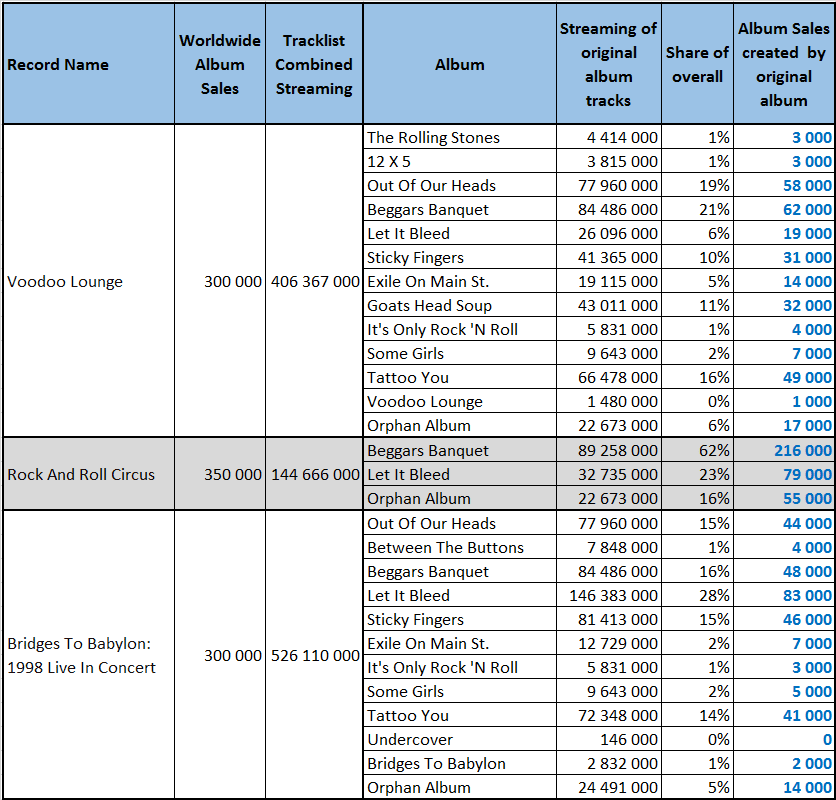
Part 12 – Music Videos III
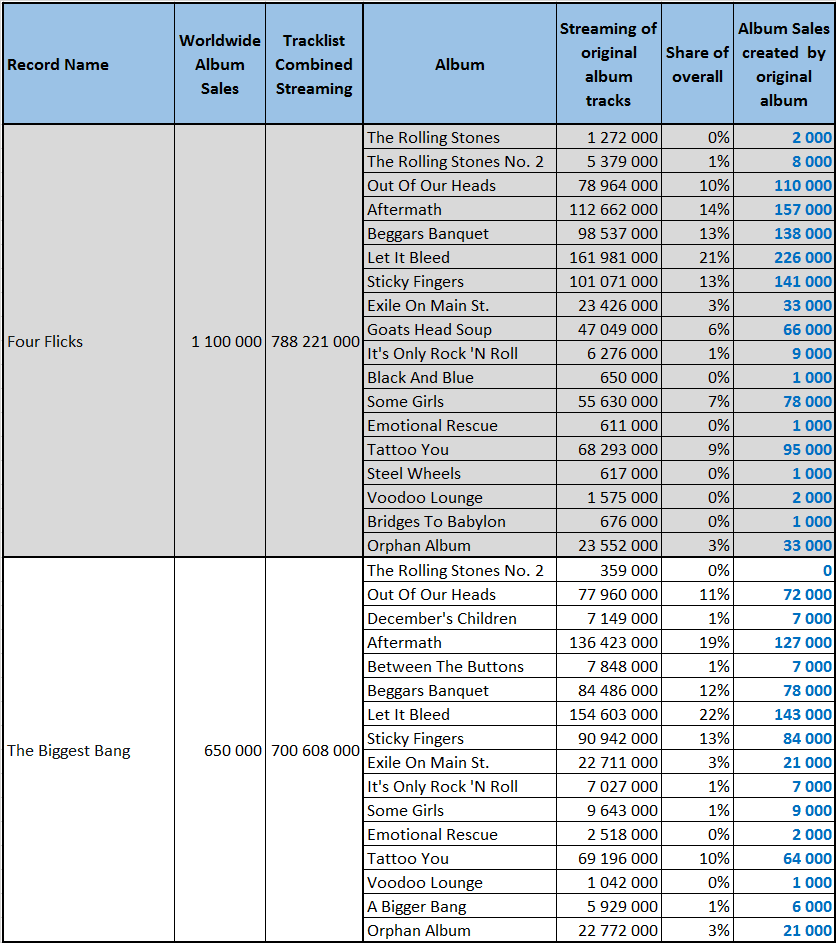
Part 13 – Music Videos IV

Part 14 – Live Albums / Music Videos I
The specificity of this list is that those records include both a Live CD album plus a music video in DVD format. Most of them came out in recent years keeping the pace of the band catalog at a fairly high level.
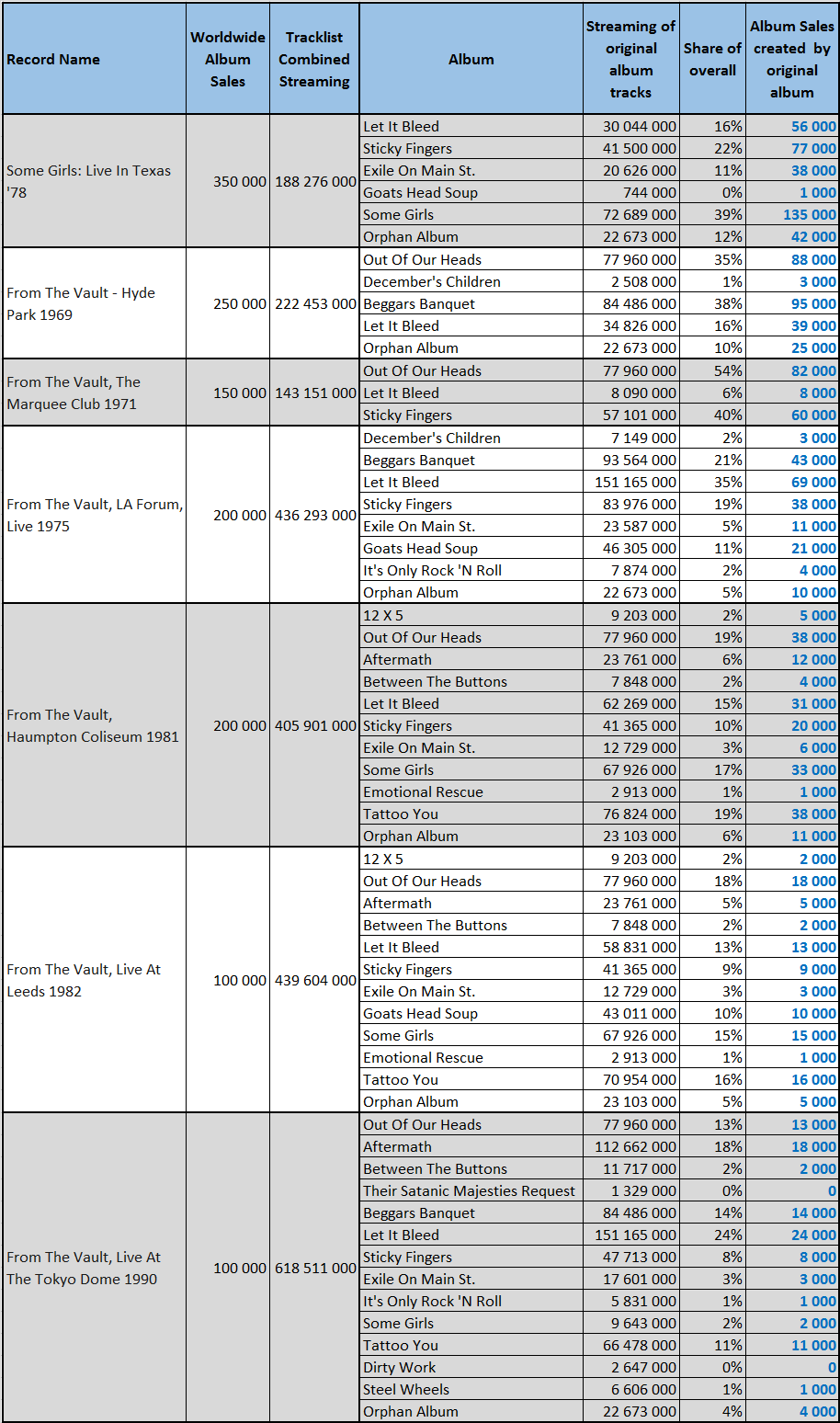
Part 15 – Missing Material
The Rolling Stones is one of those bands that have so much material out that it is impossible to list everything out. To compensate that gap to comprehensiveness I add those two packages, one for missing albums and the other for missing live videos. This covers local albums like Lo Mejor or Star Box, documentary videos like Stones In Exile or Crossfire Hurricane plus very recent issues a la Havana Moon or Totally Stripped.
Since there isn’t an identified track list for all those records, I used the distribution of GRRR! as it is the last career-spanning compilation which consequently represents best the band discography strengths and weaknesses.
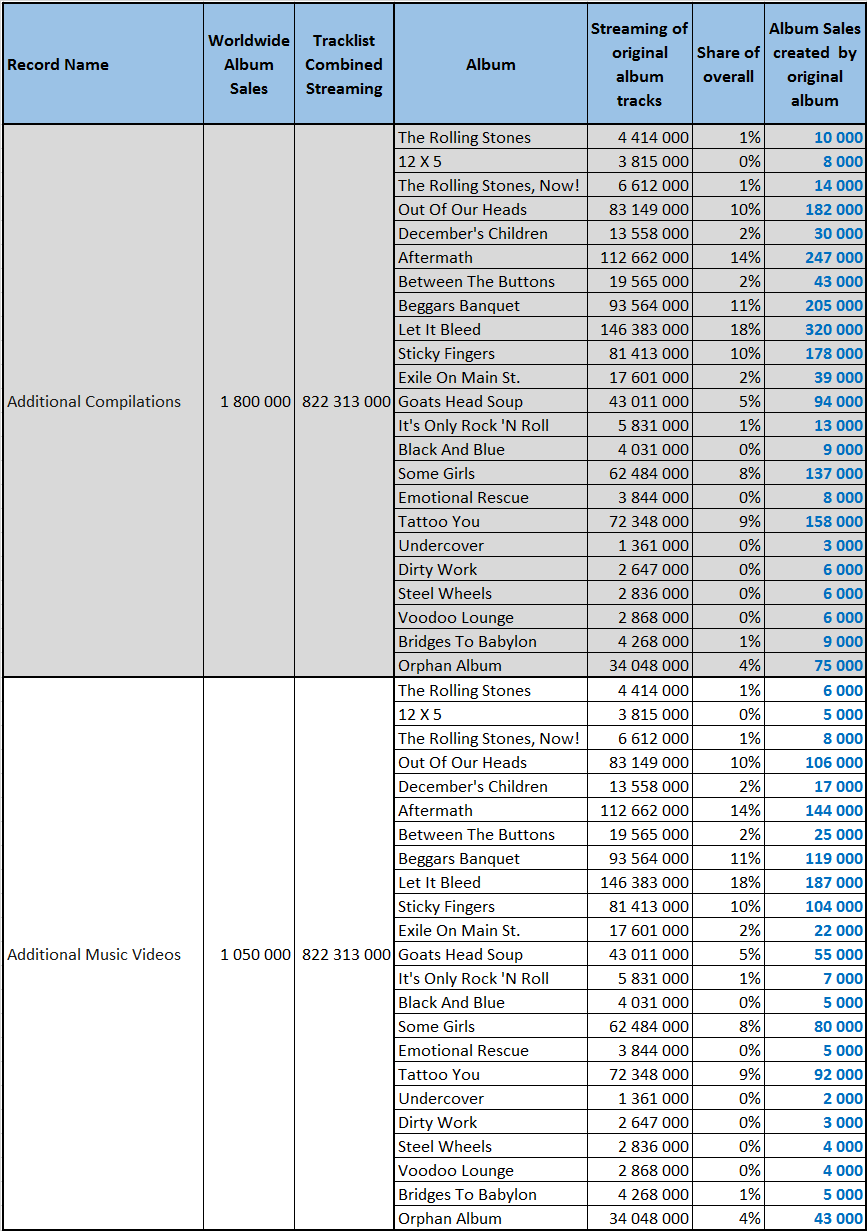
The Rolling Stones’s career CSPC results
So, after checking all figures, how many overall album sales equivalent each Rolling Stones album achieved? Well, at this point we barely need to do the addition of all figures defined all over this article!
In the following results table, all categories display figures in equivalent album sales. If different, pure sales are listed between parentheses.
As a reminder:
- Studio Album: sales of the original album
- Other Releases: sales of compilations generated thanks to the album
- Physical Singles: sales of physical singles from the album (ratio 3/10)
- Download Singles: sales of digital singles from the album (ratio 1,5/10)
- Streaming: equivalent album sales of all the album tracks (ratio 1/1500 for Audio stream and 1/6750 for Video stream)
Artist career totals
See where the artist ranks among remaining singers
Their number of 10 million sellers climbs from 1 in pure album sales to 9 when factoring in all formats and compilation sales generated. At 18,3 million, Some Girls is their fourth most successful album only in spite of being the highest seller on its own. Initially benefiting from better market environment in comparison to its predecessors, the album got matched by Sticky Fingers, Let It Bleed and Aftermath due to the immense number of compilations each one is responsible of. From 21,8 million to 19,7 million, that’s a ferocious fight for the top spot that those albums are engaged on.
In fact, the recent reissue of Sticky Fingers as late as in 2015 enabled it to be their top album but digital results are more favorable to Let It Bleed which may ultimately take over the lead, likely about 50 years after their releases.
The most surprising result is maybe Exile On Main St which ranks only 9th overall. Their only classic album that misses a truly iconic hit, this album was cannibalized way less by compilations than its contemporary albums. This explains why the 2010 reissue was so successful – it contributes in 1,3 million of the album 8,1 million pure album sales – as there was more room for sales than for other LPs which saw their singles used up to saturation point.
Studio album sales create the illusion that the band later albums have been as successful as their 1965-1981 classics. Let display the same results in graphical view to better understand what happened:
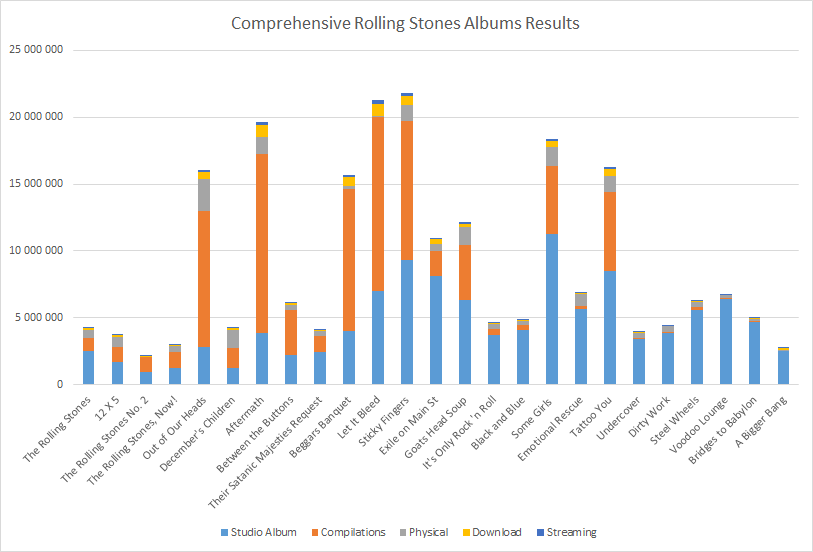
As you can see, blue bars representing studio album sales are fairly stable, including for later albums. From the album Undercover though bars are almost entirely blue. Those albums enjoyed an album market much, much healthier than their past records, which makes it look like they have been just as successful. When checking the global Commensurate Sales to Popularity Concept (CSPC) results, we are able to prove what happens to be obvious for the band followers – their 1965-1981 years are arguably much more popular than anything else.
While as many as 9 albums from that period top 10 million, 7 of which are well past 15 million, the remaining 16 albums are all under 7 million creating a true hole between the big ones and the rest of the band’s catalog.
The most striking conclusion though is the overall value of that catalog. Up to an unbelievable 237,1 million total equivalent album sales, the Rolling Stones position among the all-time greats of the music industry is legitimate as it can be.
Among all artists studied so far, only Madonna performed better. The gap of 9 million between both artists isn’t even impossible to fill though especially as the rock band ongoing catalog appeal is much bigger. Their new album Blue & Lonesome will try to add its share of sales as well to catch the original diva. Without that extra help, the Rolling Stones’ total is already some 40-ish million ahead of acts as massive as Led Zeppelin, U2 or Celine Dion.
As usual, feel free to comment and / or ask a question!
Sources: IFPI, Spotify, Chartmasters.org
We have more for you…
… the Rolling Stones‘ streaming masters analysis
… checking out the upcoming artists or even voting for them!
… similar artists
… best-selling artists, albums, and singles
Artists
360° analytics – Best-Selling Artists | by Decade
Tools: Artist Dashboard | Artists Comparator
Streaming deep dive – Most-Streamed Artists
Tools: Playcounts | Royalties | Global Reach | Stats History
Other KPIs – Monthly listeners | Followers | Top money makers
This article is being discussed in our forum, join us to share your comments! »
